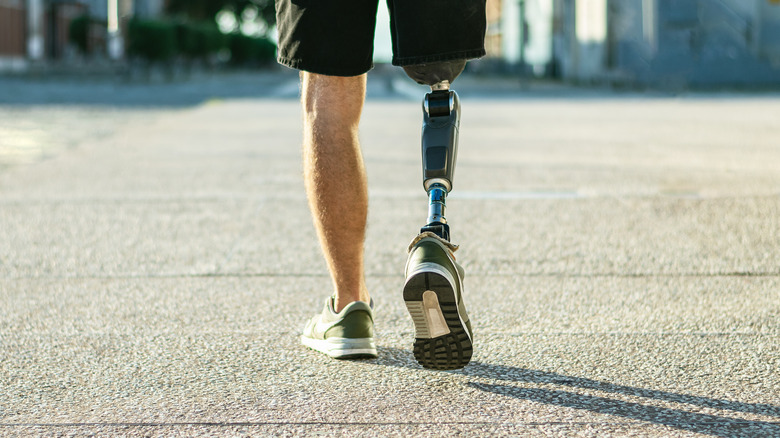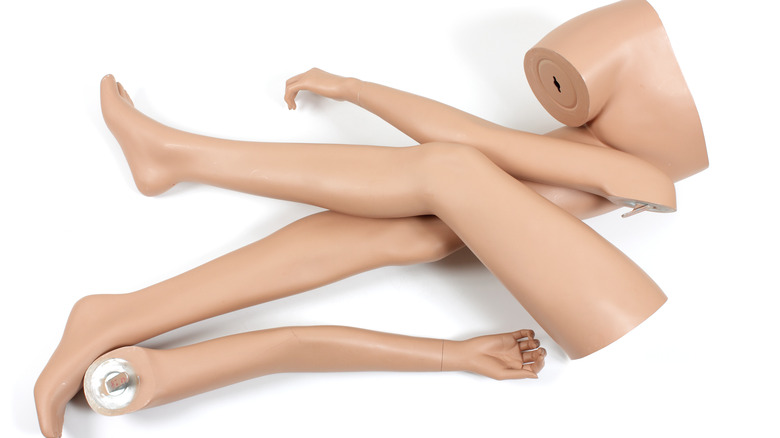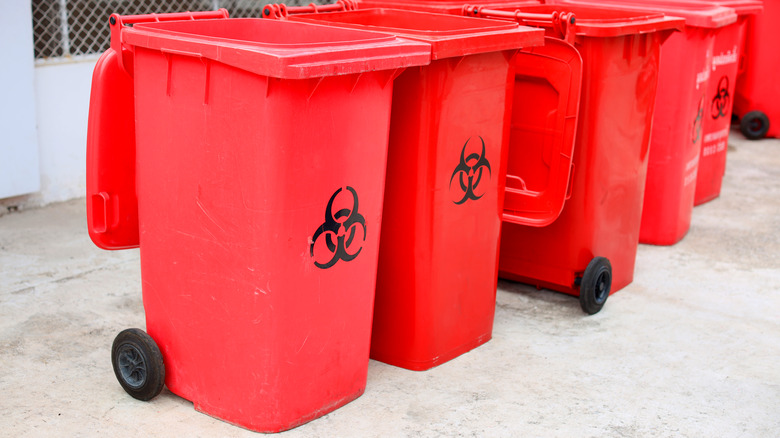This Is What Happens To Body Parts After Amputation
There are many interesting and entertaining things to see on social media, and one of them is the Instagram account "onefootwander" that occasionally shows photos of a skeletal foot in different locations. Upon closer inspection, a description of the account reads, "Used to be attached to @kristico110." That is because the foot used to be attached to her. In 2011, Oklahoman Kristi Loyall started feeling numbness in her right pinky toe. After a series of checkups and hospital visits, she learned that she had cancer in 2016, and was advised to have her right leg amputated below the knee to keep the disease from spreading.
One of the questions Loyall asked her doctor was whether or not she could keep her severed limb. It was an odd request, but she was serious about getting back her amputated foot. Loyall described herself to PBS News Hour as an oddball, and said she would have regretted it if she didn't at least ask. It turned out that she could keep it, and after her surgery, she sent her foot to Skulls Unlimited, a company that offers skull cleaning services. They whitened her foot skeleton and pinned the bones together, and now Loyall is able to take her skeletal foot on adventures.
Common causes for amputation
There are several reasons why patients need to undergo amputation of body parts, but according to the National Library of Medicine, the most common causes are diabetes and vascular disease. There is also traumatic amputation, which is the severing of a body part due to an injury or an accident. Statistics show that about 150,000 people have their lower limbs amputated each year in the U.S. If doctors find that repairing or keeping an infected or damaged body part will be detrimental to the patient, amputation is usually recommended.
It is standard procedure for hospitals to have a patient sign a waiver before undergoing a surgical amputation. Patients who sign the waiver give up ownership of the body part — also called "surgical leavings" — as soon as it is detached from the body, per Slate. Those who choose to keep the amputated part must notify the doctor beforehand to know whether it is allowed and to get information on the proper procedure.
Are amputated body parts safe to keep?
What Kristi Loyall did was unusual, but she certainly wasn't the first person who requested to take home her amputated body part. In some instances, doctors will tell their patients that taking home the body part is illegal or unsafe, but that isn't necessarily true. George Annas, a bioethicist from Boston University, told PBS News Hour that an amputated limb is generally safe, except when it has bacteria or is infected with a contagious disease. And most of the time, that's the only time doctors won't allow their patients to keep their amputated parts.
For Loyall, the procedure was fairly straightforward. She signed a release form from the hospital and after her amputation, the foot was sent to a lab for pathogen testing to ensure that it was not a public-safety hazard. After a month, the severed foot was sent back to her and she had it skeletonized.
Leo Bonten, another amputee, chose to make something useful out of his amputated leg. In 2012, Bonten suffered an accident that resulted in an infected leg, which ended up having to be amputated. According to CNN, he had to go through legal procedures to get his detached limb. It was eventually given to him, and he turned it into a fully functioning lamp, which stands (no pun intended) in his living room. The leg — preserved and not skeletonized — floats in a liquid solution inside a glass cylinder.
Exceptions to ownership of amputated body parts
According to PBS, there isn't a federal law in the U.S. that prohibits amputees from getting back their amputated body parts. "The general rule is you have custody of it, you are considered the owner of your body parts as long as they're inside of you," bioethicist George Annas said. When it is removed from the body, there are certain protocols that must be followed before it is released back to the amputee or disposed of. In Missouri, Louisiana, and Georgia, however, they have restrictions regarding the ownership and selling of human remains and body parts. In some cases, it may also be challenging for amputees to get their body parts back due to in-house rules that hospitals have to follow.
Another exception is if the amputee is Native American. The Native American Graves Protection and Repatriation Act states that Native American human remains "must at all times be treated with dignity and respect" and prevents owning and trading of body parts, as noted by the National Park Service.
Where do they go if the owners don't want them?
The majority of amputees do not want to keep their severed body parts. After a body part is removed, it may be sent to a pathogen laboratory for further testing, or it may also be donated to a laboratory, a teaching hospital, or a medical college for research, anatomy classes, or dissection (per National Library of Medicine). Others are considered medical waste and are disposed of properly following strict safety regulations.
By definition, medical waste includes materials contaminated by bodily fluids, blood, and infectious diseases. And, even body parts free of pathogens are still considered medical waste. State regulations vary when it comes to the disposal of medical waste, but they, more or less, follow the standard guidelines developed by the Medical Waste Tracking Act, according to the Environmental Protection Agency. Typically, disposed body parts from hospitals are incinerated. The proper disposal of medical waste is important in order to prevent contamination and the potential spread of diseases.
Ways of incinerating amputated body parts
According to Medical Environmental Technologies, there are three ways to incinerate amputated body parts. The first is using a controlled air incinerator, which is the most commonly used. The burning of waste is done in two stages. During the first stage, less air than required for burning is used, which results in lower temperatures. More air is added during the second stage, which completes the combustion process, as noted by the Environmental Protection Agency. The second type is the excess air incinerator, which is smaller in size and ideal for incinerating waste in batches. The third is the rotary kiln incinerator, which comes with a rotating barrel.
According to Aftermath, medical waste disposal may be done on-site or hospitals may also hire contractors that specialize in handling medical waste. After the incineration process, the remaining materials — in the form of ashes — are transported to a sanitary landfill for final disposal. A sanitary landfill is different from a regular landfill, as it is organized and government-monitored to ensure proper waste treatment.





